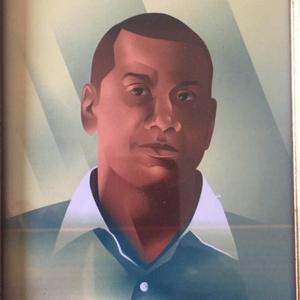"ON THE 20th CENTURY" — THE MUSICAL
The subject of this column last week was the 1932 play Twentieth Century, on which 1978's On the 20th Century is based.
In a space that you own. Make your posts free or charge for them. Anywhere in the world. Start in less than a minute.


The subject of this column last week was the 1932 play Twentieth Century, on which 1978's On the 20th Century is based.



We're starting up the month of love. Everyone knows that February is when Cupid is at his most lethal. Nappy on, bare chest and hunting bow and arrow at the ready, he's coming for everyone.



It would have been virtually impossible for me to have ever seen the actor Edward G. Robinson on stage, as when he played Broadway for the last time, it was in Paddy Chayefsky’s Middle of the Night in 1957 — the year I was born. Renowned as a film actor, it’s important to note, that like so many greats who first burst on the scene with the advent of talking pictures, Robinson was a major stage actor before he came to Hollywood in 1929. At that point, he had twenty-nine Broadway plays to his credit in the years between 1916 and 1930, nearly two per season. How’s that for a statistic? Always one of my personal favorites, Eddie G was the first actor I ever took to impersonating — at the age of five.



Looking back on my teenage theatergoing heyday, which occurred between the years 1969 and 1972, even fifty years later, the memories remain fresh and intact. From the ages of twelve to sixteen, often solely on my own, I attended 200 Broadway shows over a four-year span. I covered the costs entirely with my own money, too, earned from my paper route delivering Newsday, "the Long Island newspaper." And, yes, at the risk of repeating for those who've heard me mention it before — all at the average cost of $3 a ticket. It's chronicled in my book Up in the Cheap Seats, which tells the stories of an obsessed teenager, eagerly getting an education sadly unaffordable to a kid — or anybody today for that matter — with a shared passion like mine.



My book, Taj Mahal Foxtrot, takes its name from the tune below recorded in April 1936 by Crickett Smith and his Symphonians, the gents in that photo. They had been booked by the management of Taj Mahal hotel in Apollo Bunder to perform there for the 1936 summer season.



In the 1950s, the Anglo-Indian crooner Pamela McCarthy was among the most striking figures on the Bombay bandstand. She was always dressed in a stunning ball gown. Her swinging voice kept dancers on their floor to the very end of the set. And then, of course, there was her wheelchair.



In 2012, as I waited for Taj Mahal Foxtrot to roll off the presses, I burnt some nervous energy by trying to tame the mountain of research material that had grown steadily by the side of my computer over the previous years.



मेरी राहें अशोक रोड हैंबीजेपी ही तो मेरा हक़ हैकांग्रेस मेरी तू बेशक़ है बीजेपी ही तो मेरा हक़ है


Was Amru Sani the first Indian to make it in the exalted world of American show biz? In the 1950s, Sani had a brief streak of fame in the US, appearing in a Broadway revue and cutting a bunch of popular records. In 1953, when Sani was booked for an assignment in Hollywood nightclub called Ciro’s, the New Journal and Guide described her as “India’s Lena Horne”.


OF COURSE, as the author claims, such a judgement is intrinsically problematic. As the author says:



Presenting recitations of some of my Ghazals. Available on Spotify, Google Podcasts, etc



Introduction



Can a title music also be used as background score ? Let's take a closer look at the title track that is loved by one n all.



Bilas Khan, an acclaimed singer, son and disciple of the legendary Tansen, is often credited as the creator of the Raga Bilaskhani Todi. The story goes that when Tansen died, Bilas Khan sang this Raga so emotionally and beautifully that Tansen stirred! And it came to be called Bilaskhani Todi.


Along with Chandraveena music, we have been working on multiple projects to expand the Universe of Indian Classical Music. We are very excited to announce the launch of our latest project, Ragatronics. Our first album, Igniting the Flame, with 10 tracks has just been released on Bandcamp. A track a week will also be released on YouTube channel of Ragatronics.Ragatronics combines the core musical aspects of Ragas in Indian Classical Music with elements from Rock, Jazz and Electronic music. This is done by composing a musical code, synthesizing the music from that and occasionally adding samples or snippets of real instruments.The idea of Ragatronics is to explore Ragas and harmonies in Ragas, within the framework of a Tanpura tuning, and a musical scale consonant with that tuning. You may notice while listening to the album that different tracks have a slightly different Tanpura tuning, playing in the background.You can stream, listen and purchase the album at: ragatronics.bandcamp.com/releases To know more about this project, please visit: ragatronics.sadharani.comDo write to us with your feedback. If you like the music, please share the link with your friends and family, and spread the word.Enjoy the music!


When it came to compose for a lady in a rural scene, nobody could come close to Gulzar and Pancham. Let's explore one of the sparkling gems of this duo.



An abridged version of this piece was carried in The Hindu dated May 06, 2021



My contributions to the Saptak Audio Podcast, entitled 'Flows of Tradition'






Srijan Deshpande performs Live for Sangeet Srushti's FB Page, 21st Feb 2021
